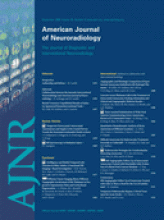Abstract
BACKGROUND AND PURPOSE: Early evaluation of the pyramidal tract is a prerequisite in patients with intracerebral hemorrhage (ICH) in order to decide the optimal treatment or to assess appropriate rehabilitation. The aim of this study was to evaluate and predict the neuromotor and functional outcome of an ICH by using diffusion tensor imaging (DTI) in the acute phase.
MATERIALS AND METHODS: Eighteen patients with a hemiparetic supratentorial ICH were prospectively studied with DTI within 2 days after onset. A region-of-interest-based analysis was performed for the fractional anisotropy (FA) of the pyramidal tract in the cerebral peduncles. The degree of paresis was assessed at day 0 and day 28 by paresis grading (PG). The functional outcome was evaluated by the modified Rankin Scale (mRS).
RESULTS: The FA in the affected side was significantly lower compared with that of the unaffected side (P = .001) with the mean diffusivity remaining unchanged (P = .50). The ratio of the FA (rFA) in the affected side to the unaffected side was significantly correlated with the PG at day 0 and 28 and the mRS score at day 28 (P = .002, r = −0.674; P < .001, r = −0.767; and P = .002, r = −0.676). The rFA for the good and poor outcomes based on the PG was significantly different (P < .001). The cutoff point of the rFA for the good and poor outcomes was set at 0.85 (sensitivity, 100%, specificity, 100%).
CONCLUSIONS: We conclude that DTI can evaluate the motor deficit quantitatively and may predict the functional outcome in patients with an ICH who were scanned within 2 days after the ICH onset.
- Copyright © American Society of Neuroradiology












